Hewlett Packard WES - Create and configure the WES profile
Create the WES profile
On a clean Watchdoc installation, a first WES profile is automatically created with default parameters at the end of the wizard procedure, but you can, at any time, edit existing profiles to modify them or create a new profile.
-
From the Main menu in the administration interface;
-
in the Configuration section, click on Web, WES & Scan destinations:
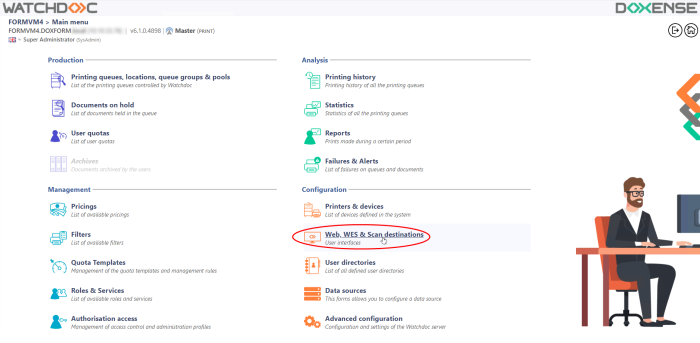
-
in the Web, WES & Scan Destinations - Client Interface Management interface, click on Create a new WES profile;
-
in the list, select the profile you want to create:
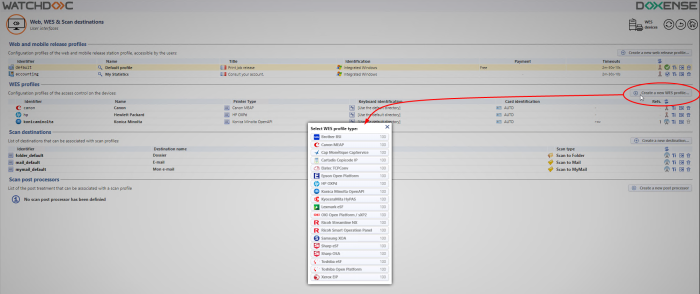
è you will access the Create a WES profile form, which contains a number of sections in which you can configure your WES.
A navigation bar helps you quickly access the desired section:
Configure the WES profile
Configure the Properties section
Use this section to state the main WES properties:
-
Identifier: Enter the single identifier for the WES profile. It can comprise letters, numbers and the '_' character with a maximum of 64 characters. This identifier is only displayed in the administration interfaces.
-
Name: Enter the WES profile name. This explicit name is only displayed in the administration interfaces.
-
Global: In the case of a domain configuration (master/slaves), tick this box to replicate this profile on the slave servers.
-
Language: Select the WES display language configured from the list. If you select Automatic detection, the WES adopts the language it finds by default in the device configuration.
-
Version: Select the version of WES. For v3, you can customise the interface by choosing the colour of the buttons and images to match your graphic identity:
-
Colour: enter the Hexadecimal color value corresponding to the WES button's colour. By default, the buttons are Watchdoc orange customized (#FF901). Once the value is entered, the colour is displayed in the field.
-
Images: if you want to customize the WES images, enter the folder path in which are recorded images you want to display instead of the default images (stored in C:\Program Files\Doxense\Watchdoc\Images\Embedded\Doxense\[Manufacturer_Name] by default).
see Customize the WES.
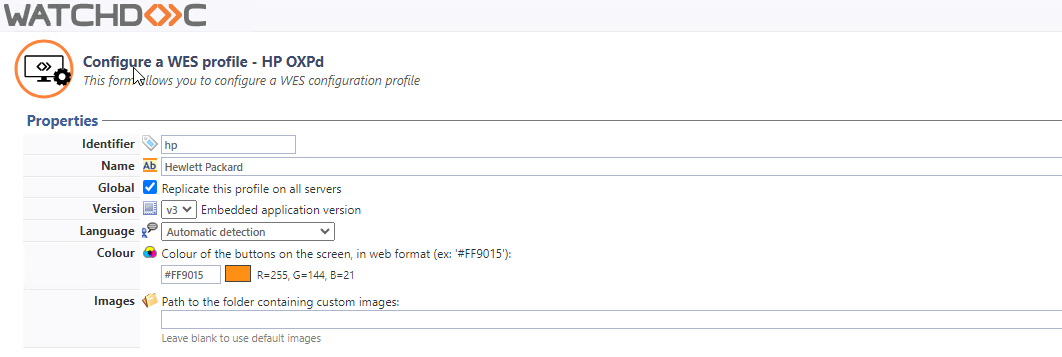
-
Configure the keyboard authentication mode
-
Keyboard authentication: tick the box (at the section level) to enable user authentication from a physical keyboard or the touch screen one, then set out how this authentication works:
-
Directory: From the list, select the directory to query during keyboard authentication. If no directory is set, Watchdoc will query the default directory.
-
PUK
(Print User Key). In Watchdoc, this is a code (associated with a user account but used alone) sufficient to allow the user to authenticate in a WES. The PUK code is generated thanks to an algorithm. The user can consult it in the "My account" page of Watchdoc. For security reasons, we advise against using the PUK code and recommend using a login (user account)/PIN code. Code: the PUK code is automatically generated by Watchdoc according to the parameters defined in the directory and communicated to the user on the "My account" page.
Login and PIN Code: consisting of 4 or 5 digits, the user PIN code (1234, for example) is registered as anLDAP attribute or in a CSV file. It is associated to the user login (available with the Watchdoc 5.1 version).
Login and password: users will use their LDAP credentials. We do not recommend using this mode :
Configure the card authentication mode
Card authentication: tick the box (at the section level) to enable user authentication from a card, then set out how this authentication works:
-
Directory: From the list, select the directory to query during cards authentication. If no directory is set, Watchdoc will query the default directory.
-
Self registration : If you enable the self-registration
 An action in which a user account is associated with its own card code. Registration is carried out the first time a card is used. The registration can be carried out by the IT manager when he issues the card to a user or by the user himself who enters his identifier (PIN code, PUK code or username and password) which is then associated with his card code. Once the registration is completed, the card code is permanently associated with its owner. from the WES, state how the user assigns their card to their account:
An action in which a user account is associated with its own card code. Registration is carried out the first time a card is used. The registration can be carried out by the IT manager when he issues the card to a user or by the user himself who enters his identifier (PIN code, PUK code or username and password) which is then associated with his card code. Once the registration is completed, the card code is permanently associated with its owner. from the WES, state how the user assigns their card to their account:-
Disabled: the self-registration is not allowed: if the user is unknown, an error message is displayed;
-
with PUK code: the embedded solution will ask the user for its PUK code. If the PUK code is correct, Watchdoc stores the card number with the user's login in its database;
-
with login and PIN code: the embedded solution will ask the user for his login and his PIN cpde.
-
with login and password: the embedded solution will ask the user for his login and his password. If the data keyed in are correct, Watchdoc stores the card number with the user's login in its database.
-
Notify the user on self-registration: check this box to send a notification to the user when his badge has been enrolled.
-
-
Format : State, where necessary, how the character string for the badge number string is to be transformed. E.g. raw;cut(0,8);swap.
Specificity of the Format parameter: typically, when the code PUK is stored in an attribute of the LDAP directory, it is encoded for security reasons. Obtaining the code corresponding to that of the badge therefore requires a transformation of the format read by the badge reader. If you have a problem setting this parameter, contact Doxense Support.
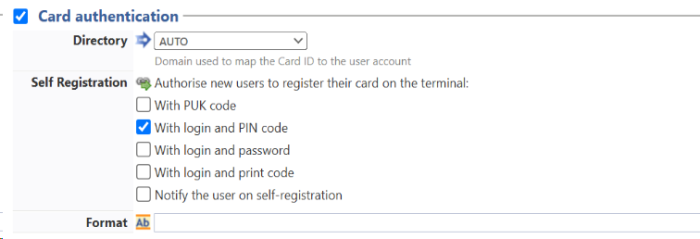
Configure the Anonymous section
Tick this section to activate the Anonymous connection in order to allow an unauthenticated user to access to the device by clicking a button.
It is possible to restrict the features that the anonymous user can access by applying a privilege policy to the queue, group, or server, and using the Anonymous User filter.
-
Button Label: Enter in this field the label displayed on the access button to the device features. By default, the text is Anonymous;
-
Redirection: From the list, choose the application to which the anonymous user must access after clicking the Anonymous:
-
Home: The user accesses to the device homepage;
-
Copy Application: The user accesses to the copy application;
-
Scan Application: The user accesses to the scan feature;
-
Fax application: The user accesses to the scan feature;

-
Configure the Accounting section
In this section, specify whether you want the accounting to be performed by the device itself or from the Watchdoc parser.
- Device > Uses the prints accounting information from the device : tick this box if you want accounting to be supported by the device instead of the Watchdoc parser. This only applies to print jobs. Results are more reliable especially when the job is not fully printed (canceled).

Configure the Pull-print section
In this section, you can change options about the Watchdoc release application: sort order of the document, tariff information and optional pages.
You can bypass this application by enabling the automatic release mode. When the user is authenticated on the device, all its documents are released.
-
Sort Order: Set the documents order on the device screen:
-
Reverse chronological: More recent documents will top the list ;
-
Chronological: Older documents will top the list.
-
-
Options:
-
Release all documents at login: tick the box to ensure that all queued jobs are automatically printed when the user logs on to the print device. In this case, the user does not access the list of queued jobs to validate which ones to print.
-
All documents are checked by default: tick the box to ensure that all pending jobs are automatically ticked in the list of pending jobs when the user authenticates.
-
-
Display Options: from the list, select the pricing information displayed to the user via the WES: none, the price or the cost of their printouts
-
Force the monetary display to 2 decimal digits: Tick the box to limit the number of decimal digits displayed to the user in the tariff information.
-
Display print policy warning messages: tick this box if you wish to inform users of the printing policy in place which could change their initial choices.
-
Optional pages:Tick the box to enable user adding more pages previews:
-
Enable Page Zoom: User can have a page by page preview (PCL 6 driver required)
-
Enable spool edition: User can modify the initial printing criteria;
-
Use a custom logo: (for WES V2 only) tick the box if you want to display a custom logo instead of the default Watchdoc logo.Then specify the path of this logo in the Properties > Images field.
-
-
Monetary symbol: Tick the box if you want to customize the monetary symbol and enter a currency symbol other than the default € one.
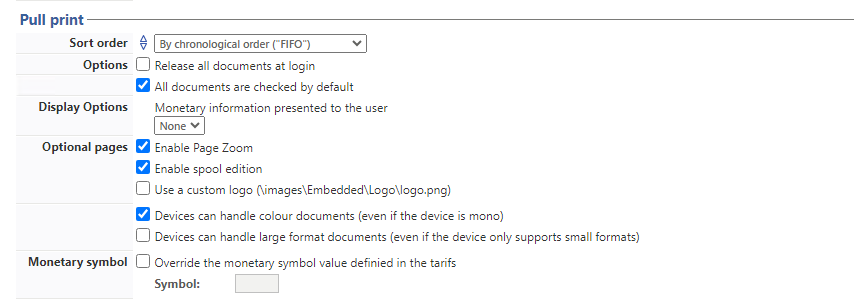
Configure the Device section
This section is used to define the connection mode between the server and the print devices.
-
Fault tolerance: tick this box to enable fault tolerance based on load-balancing. If you enable this function, you will need to configure interserver printing (see Configuring interserver printing).
-
Server Address type: The device needs to contact the Watchdoc server when the user tries to connect or wants to release his documents. You can specify the Watchdoc server address in four different ways: IP Address, DNS address, DNS alias or Custom address ;
-
Device security: Indicate the device administrator login and password which Watchdoc needs to communicate with it during certain operations (automatic installation, SOAP requests, etc.)
-
Time settings:
-
badge reader timeout: specify (in seconds) the time after which badge reader events are no longer sent;
-
authentication screen refresh: specify (in seconds) the refresh time for authentication information:
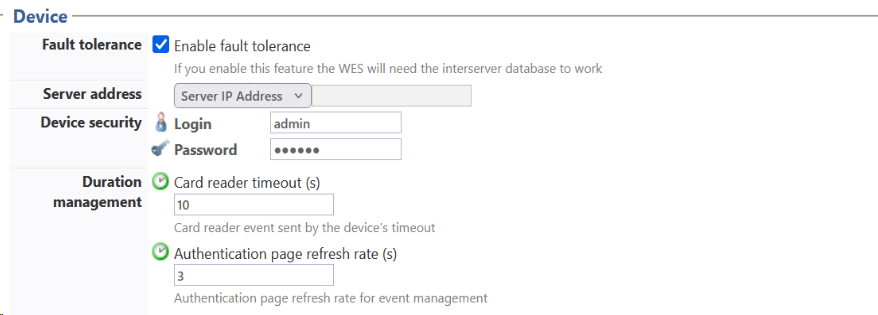
-
Configure the Scan section
This section is used to configure the WEScan function. It can only be activated with a WES V3.
-
Display preferences- Use the last values chosen by users: allows the user to be offered the most used scanning profiles (predefined settings), which offers a time saving when scanning uses are often the same. Then specify whether the classification should be done using:
-
the type of profile: (the most frequently chosen profile);
-
the date of use (profile chosen the last time it was used).
-
-
Open default profile bar: provides an interface in which the user can choose between all the scanning parameters, which is useful when the scanning uses are very varied. Then specify whether you want to display the settings or the (pre-set) profiles.
-
the scan settings ;
-
the scan profiles (pre-configured).
-
-
Allow users to switch display modes: tick this box to allow the user to customize their interface by choosing their preferred display mode.
-
Scan profiles: for each profile listed, you can check:
-
activation: to make it active in the embedded interface;
-
inheritance: to allow the user to create a new profile inheriting the parameters of the existing profile. The user will then be free to modify one or more parameters of the original profile;
-
Post processing: if a post-scan treatment has been configured (see Post-scan processor), select it from the list ;
-
destinations : the destination is the place where the scanned document is sent. For each profile, you can activate, deactivate and define one or more destinations by default:
-
E-mail: Send the scan to the e-mail of a recipient entered in the interface;
-
My e-mail: send the scan to the user's email (always known if the user has an AD account);
-
Folder: send the scan to a predefined folder in the workspace accessible to the user.

-
-
Configure the Lockout section
In this section, you can configure the functions that are made accessible or inaccessible to users:
-
Features always granted:The GUID of each application installed on the device can be found in the WEStraces once the WES has been installed (for example: "Print in color" = "68bccf58-bfd7-422e-9788-29a36dc061cd").
-
Locking mode: from the list, select the appearance of the device screen when locked:
-
Full - login screen: the user is asked to log into the WES using the credentials configured in the Authentication sections (by PUK code, user name and PIN code, user name and password or by card):
-
Full - Home screen: all applications are locked, but their icons are visible. After selecting an application, the user must authenticate before accessing it.
-
Selective: you can select which applications will be locked (ticked box) and which will be open access (unticked box).
-
-
Administration: gives access to the WES administration interface;
-
Reports: gives access to the following report pages:
-
Status page: provides information about the device's counters;
-
Configuration page: displays the device configuration page (address, ports, etc.);
-
Other pages: displays other report pages.
-
-
Device maintenance: gives access to the device maintenance interface;
-
Job Status: gives access to a page displaying the status of print jobs;
-
Supplies: gives access to a page showing the status of consumables;
-
Supplies status page: gives access to a page displaying the status of consumables;
-
Color usage: gives access to a page for using colour printing;
-
Trays: gives you access to a page displaying the status of the bins;
-
Photocopy ID card: gives access to the photocopy function
-
E-mail:Scan to mail: allows you to scan and send documents to an e-mail address;
-
Fax: accesses the fax function;
-
Retrieve from memory: allows you to print jobs saved in the device's internal memory;
-
Retrieve from USB: allows you to print jobs from a USB stick plugged directly into the device;
-
Save to memory: saves jobs to the device;
-
Save to network directory: scan to directory: scan and save to a network folder;
-
Save to SharePoint: scan to a SharePoint folder;
-
Save to USB:Scan to USB: scans and saves to a USB memory device.
-
-
-
Unavailable features: By default, applications not listed are not locked. You can add to the list by clicking on the Add a new permission button and entering the name and GUID of the application.The GUID of each application installed on the device can be found in WEStraces once the WES has been installed.
Configure the History section
This section displays information on the configured WES and on modifications made to it :
Validate the profile
1. Click on the  button to validate the WES profile configuration.
button to validate the WES profile configuration.
è Once validated, the WES profile can be applied to a print queue.
